
Jar, attributed to Morgan pottery, Cheesequake, New Jersey, 1775–1784. Salt-glazed stoneware. H. 12 1/4". (Private collection; photo, Gavin Ashworth.) This vessel is decorated with three cobalt-blue watch-spring designs on the front and back, as well as cobalt-blue rings at the base of each handle and cobalt-blue paired watch springs adjacent to the lower end of both vertically oriented handles.

Jar, attributed to Morgan pottery, Cheesequake, New Jersey, 1775–1784. Salt-glazed stoneware. H. 11 1/4". Mark: inscribed in cobalt blue on each side, “2” (Private collection; photo, Gavin Ashworth.) This vessel’s decorative elements are paired cobalt-blue watch-spring designs on the front, back, and below the handles, plus blue rings at the base of each handle.
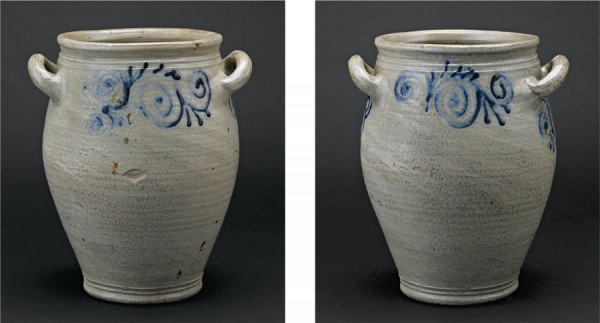
Jar, Kemple pottery, Hunterdon County, New Jersey, ca. 1746–1790s. Salt-glazed stoneware. H. 11". (Courtesy, MCHA, Gift of Mrs. J. Amory Haskell; photo, Gavin Ashworth.) The attribution is based on the cobalt-blue cogged watch-spring decoration on sherds found at the Kemple pottery site.

Jar, attributed to Kemple pottery, Hunterdon County, New Jersey, ca. 1746–1790s. Salt-glazed stoneware. H. 9 3/4". (Courtesy, Marshall P. Blankarn Purchasing Fund, MCHA; photo, Gavin Ashworth.) The attribution is based on the similarity to the Sim notebook drawing on the left in fig. 53.
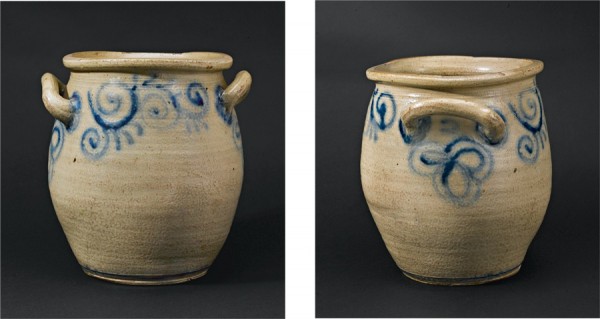
Jar, attributed to Kemple pottery, Hunterdon County, New Jersey, ca. 1746–1790s. Salt-glazed stoneware. H. 11". (Private collection; photo, Gavin Ashworth.) Cogged watch-spring motifs adorn both sides, and there are three concentric ovals under each handle. The design below each handle is not found among the examined sherds.
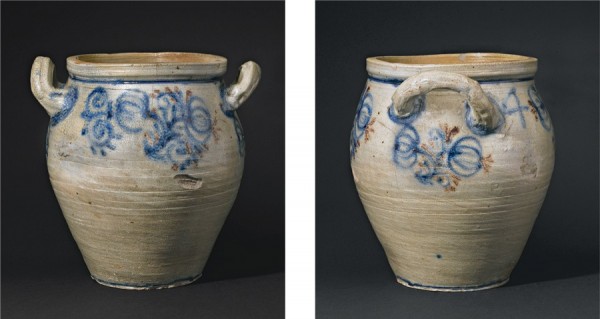
Jar, attributed to Kemple pottery, Hunterdon County, New Jersey, ca. 1746–1790s. Salt-glazed stoneware. H. 14". Mark: inscribed in cobalt blue, “4” (Private collection; photo, Gavin Ashworth.) This jar, which has exceptionally bold and unusually large loop handles, is decorated with several cobalt-blue elements: floral motifs and cogged watch-spring designs on both front and back; pomegranates accented with reddish brown cogs; circular cobalt-blue bands under the neck, at the base, and around all four handle bases; and a paired pomegranate design below each handle. Manganese or iron glaze accentuates the cogs, stems, and tips of the pomegranates.
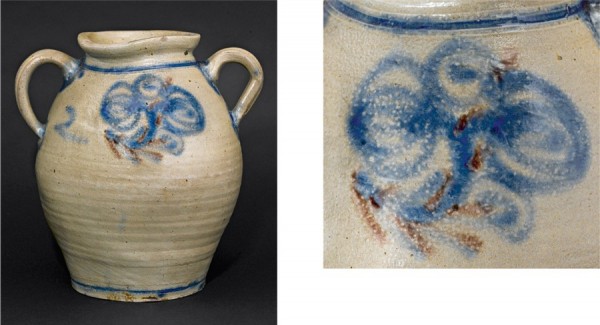
Jar, attributed to Kemple pottery, Hunterdon County, New Jersey, ca. 1746–1790s. Salt-glazed stoneware. H. 12 3/4". Mark: inscribed in cobalt blue, “2” (Private collection; photo, Gavin Ashworth.) This vessel has vertical handles and cobalt-blue decoration consisting of matching pomegranate designs (similar to the sherds illustrated in fig. 58) on the front and back, and a circular cobalt-blue band at the neck and base. Reddish brown cog accents on the shoulder are cobalt blue, similar to the jar illustrated in fig. 6.

Jar fragment, Morgan pottery, Cheesequake, New Jersey, 1775–1784. Salt-glazed stoneware. (Courtesy, Robert J. Sim Collection, MCHA; photo, Gavin Ashworth.) A typical example of Morgan’s cobalt-blue watch-spring motif.
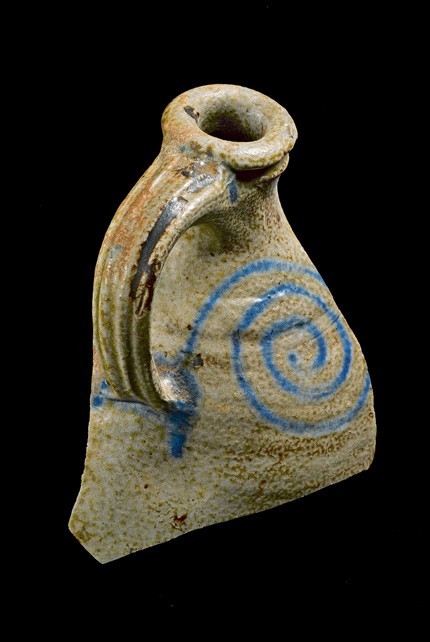
Jug fragment, Morgan pottery, Cheesequake, New Jersey, 1775–1784. Salt-glazed stoneware. (Courtesy, Robert J. Sim Collection, MCHA; photo, Gavin Ashworth.)

Chamber pot, Morgan pottery, Cheesequake, New Jersey, 1775–1784. Salt-glazed stoneware. H. 6". (Courtesy, Robert J. Sim Collection, Marshall P. Blankam Purchasing Fund, MCHA; photo, Gavin Ashworth.) The decoration includes triangular dotted patterns.

Chamber pot, Morgan pottery, Cheesequake, New Jersey, 1775–1784. Salt-glazed stoneware. H. 6". (Courtesy, Robert J. Sim Collection, Marshall P. Blankam Purchasing Fund, MCHA; photo, Gavin Ashworth.) One side of the chamber pot is decorated with a cobalt-blue, triple watch-spring design surmounted by a dot pattern; the other shows a floral motif emerging from a spiral.
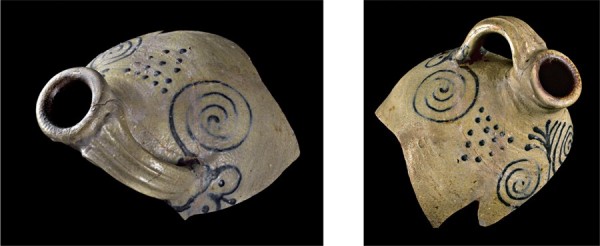
Jug fragment, Morgan pottery, Cheesequake, New Jersey, 1775–1784. Salt-glazed stoneware. (Courtesy, Robert J. Sim Collection, NJSM; photo, Gavin Ashworth.) The fragment with triangular patterns of dots has two large spirals touching each other with a central foliate design rising above and between them. Below the handle is a circular dotted decoration.
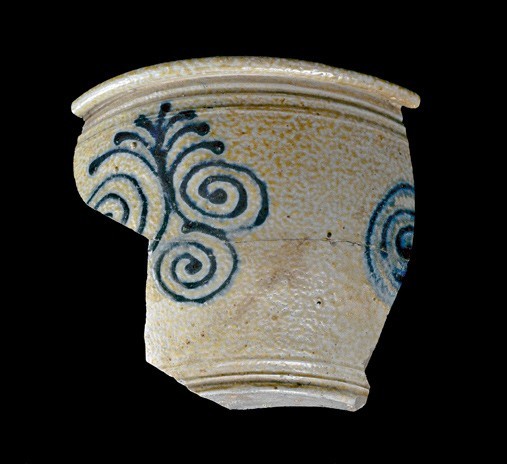
Jar fragment, Morgan pottery, Cheesequake, New Jersey, 1775–1784. Salt-glazed stoneware. (Museum Purchase/Gift of Mrs. Robert J. Sim, CH174.112, NJSM; photo, Gavin Ashworth.) The decoration on this sherd is a triple spiral from which a branching foliate motif emerges. A jar attributed to Morgan, currently in the Thomas Warne Museum, Old Bridge, New Jersey, has a similar triple spiral on one side and a quadruple spiral on the other side.
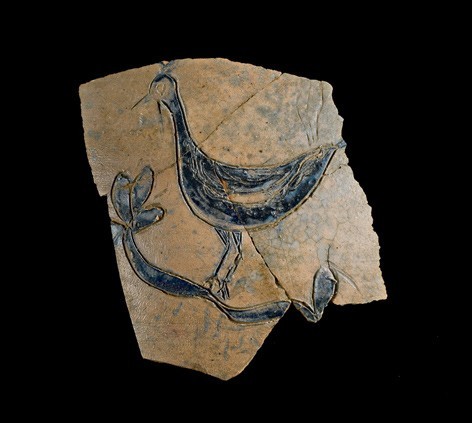
Jar fragment, Morgan pottery, Cheesequake, New Jersey, 1775–1784. Salt-glazed stoneware. (Courtesy, Robert J. Sim Collection, MCHA; photo, Gavin Ashworth.) Depicted is a finely incised, cobalt-blue bird with a long neck and a crest, standing on a vine.
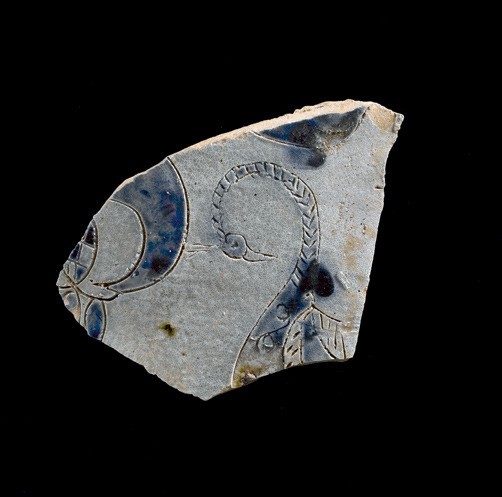
Sherd, Morgan pottery, Cheesequake, New Jersey, 1775–1784. Salt-glazed stoneware. (Courtesy, Robert J. Sim Collection, MCHA; photo, Gavin Ashworth.) Drawn on this fragment is a finely incised, cobalt-blue bird with an extremely long feathered neck, a bill, and a crest.
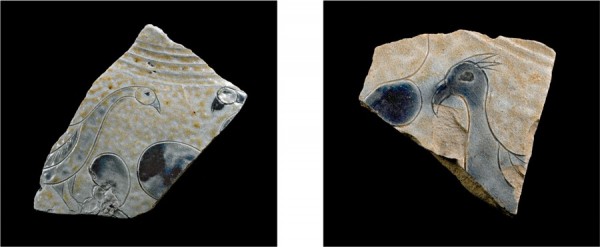
Sherds, Morgan pottery, Cheesequake, New Jersey, 1775–1784. Salt-glazed stoneware. (Courtesy, Robert J. Sim Collection, MCHA; photo, Gavin Ashworth.) These fragments show incised birds filled in with cobalt blue.
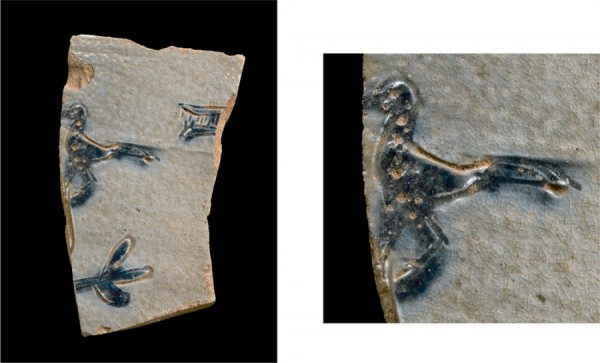
Sherd, Morgan pottery, Cheesequake, New Jersey, 1775–1784. Salt-glazed stoneware. (Courtesy, Robert J. Sim Collection, MCHA; photo, Gavin Ashworth.) At far right is a detail showing the partial image of a bird, incised and filled in with cobalt blue, above what might be another bird’s foot.
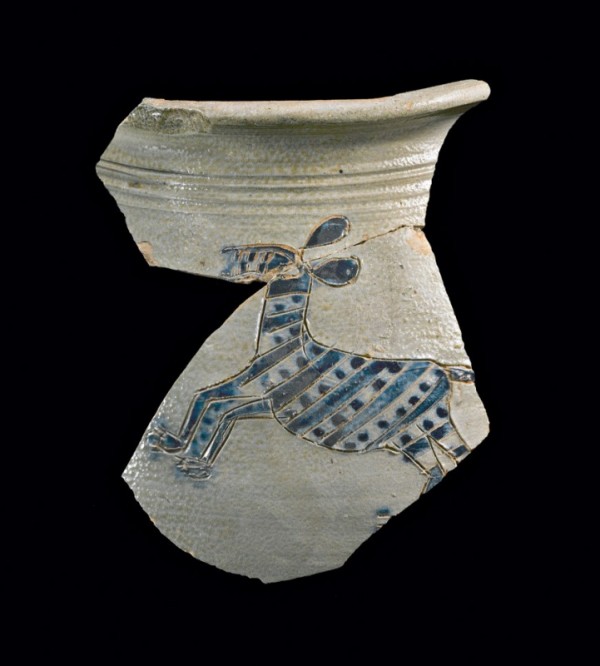
Sherd, Morgan pottery, Cheesequake, New Jersey, 1775–1784. Salt-glazed stoneware. (Courtesy, Robert J. Sim Collection, MCHA; photo, Gavin Ashworth.) This fragment is decorated with an imaginatively drawn zebra; its body is decorated with diagonal cobalt-blue stripes alternating with blue dots.
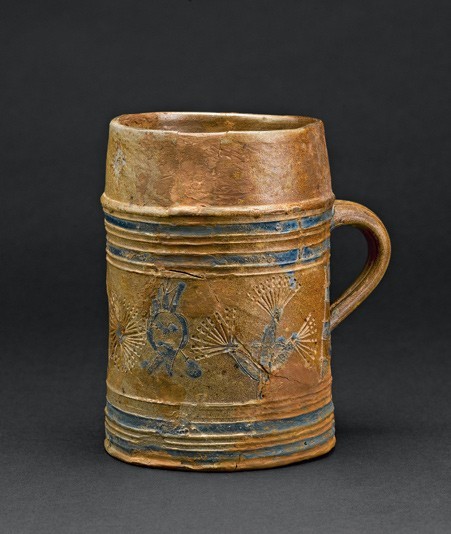
Mug, Morgan pottery, Cheesequake, New Jersey, 1775–1784. Salt-glazed stoneware. H. 6 3/4". (Museum Purchase/ Gift of Mrs. Robert J. Sim, CH174.112, NJSM; photo, Gavin Ashworth.) This restored mug, one of four known, shows a partially incised caricature of a human face, outlined in blue, adjacent to a stylized plant.
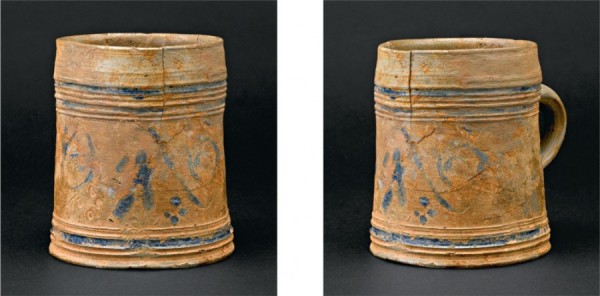
Mug, Morgan pottery, Cheesequake, New Jersey, 1775–1784. Salt-glazed stoneware. H. 4 3/4". (Courtesy, Robert J. Sim Collection, Newark Museum; photo, Gavin Ashworth.) The cobalt-blue decoration on this restored mug is not as developed as that seen on other examples.
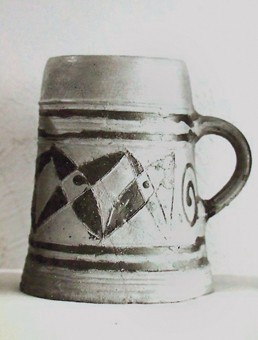
Mug, Morgan pottery, Cheesequake, New Jersey, 1775–1784. Salt-glazed stoneware. (Reproduced from a photograph in Sim and Clement, “The Cheesequake Potteries,” p. 123, fig. 3; Robert J. Sim Collection, NJSM.) This mug, whose location is unknown, is decorated with a geometric triangle-and-square pattern and a coiled spring at its handle.

Mug, Morgan pottery, Cheesequake, New Jersey, 1775–1784. Salt-glazed stoneware H. 6 1/2". (Courtesy, Robert J. Sim Collection, Newark Museum; photo, Gavin Ashworth.) The design on this restored mug is a variant of that seen on the fragment illustrated in fig. 27.
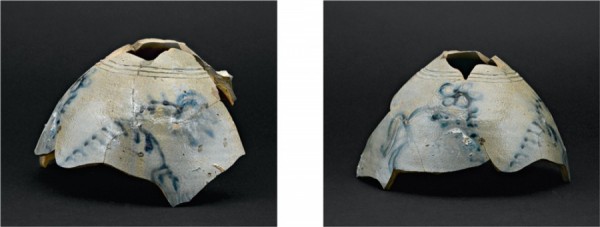
Jug fragment, Morgan pottery, Cheesequake, New Jersey, 1775–1784. Salt-glazed stoneware. (Courtesy, Robert J. Sim Collection, MCHA; photo, Gavin Ashworth.) On one side of this fragment from a partially restored large jug is a fuchsia-like flower on a thorny branch; on the other are a brushed flower with petals and another fuchsia-like flower on thorny branches.
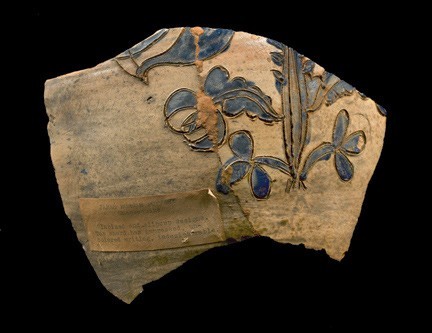
Jar fragment, Morgan pottery, Cheesequake, New Jersey, 1775–1784. Salt-glazed stoneware. (Courtesy, Robert J. Sim Collection, MCHA; photo, Gavin Ashworth.) The leaves of the incised fuchsia-like flower on this fragment are filled in with cobalt blue.

Sherds, Morgan pottery, Cheesequake, New Jersey, 1775–1784. Salt-glazed stoneware. (Courtesy, Robert J. Sim Collection, MCHA; photo, Gavin Ashworth.) The incised leaves shown here, one of which also has the incised figure of a bird, are filled in with cobalt blue.
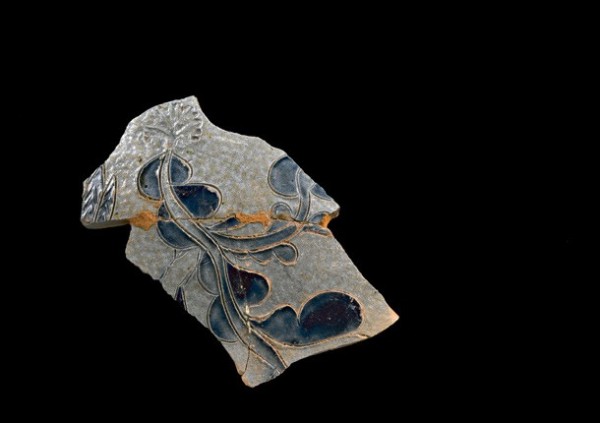
Sherd, Morgan pottery, Cheesequake, New Jersey, 1775–1784. Salt-glazed stoneware. (Courtesy, Robert J. Sim Collection, MCHA; photo, Gavin Ashworth.) In addition to the incised, cobalt-blue leaves, this piece also has a partially incised flower at the top.

Jar fragment, Morgan pottery, Cheesequake, New Jersey, 1775–1784. Salt-glazed stoneware. (Courtesy, Robert J. Sim Collection, MCHA; photo, Gavin Ashworth.) This example bears an elaborate slip-decorated flowerhead.

Sherd, Morgan pottery, Cheesequake, New Jersey, 1775–1784. Salt-glazed stoneware. (Reproduced from a photograph in Sim and Clement, “The Cheesequake Potteries,” p. 123, fig. 1; Robert J. Sim Collection, NJSM.) The sherd, known only from this published photograph, is illustrated with a fuchsia-like flower.
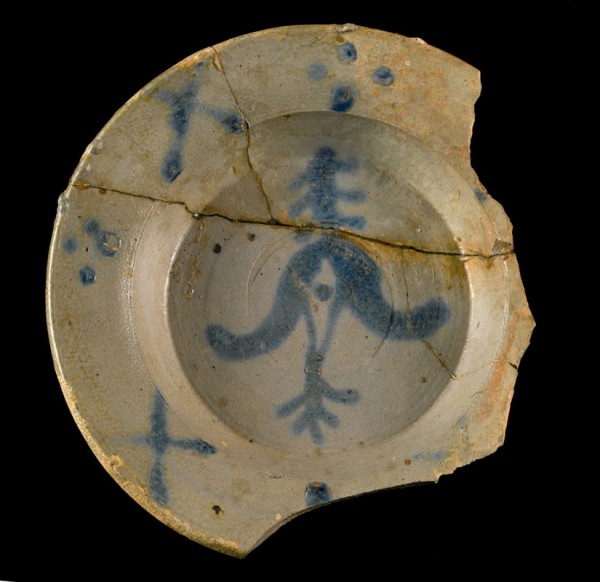
Plate fragment, Morgan pottery, Cheesequake, New Jersey, 1775–1784. Salt-glazed stoneware. (Courtesy, Robert J. Sim Collection, MCHA; photo, Gavin Ashworth.) This partially mended plate is decorated with an elaborate floral motif in the center.
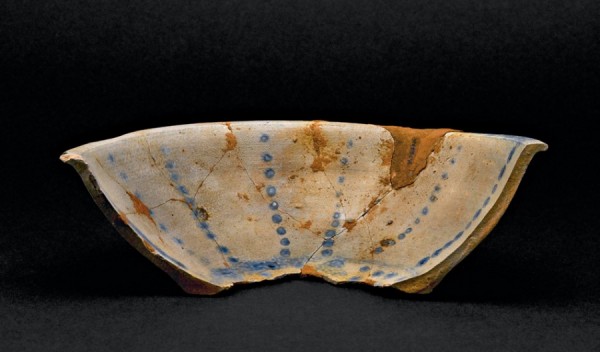
Bowl fragment, Morgan pottery, Cheesequake, New Jersey, 1775–1784. Salt-glazed stoneware. (Courtesy, Robert J. Sim Collection, MCHA; photo, Gavin Ashworth.) The decoration of this partially reassembled bowl consists of vertical rows of cobalt-blue dots on the inside.

Sherd, Morgan pottery, Cheesequake, New Jersey, 1775–1784. Salt-glazed stoneware. (Courtesy, Robert J. Sim Collection, MCHA; photo, Gavin Ashworth.) A diamond-shaped pattern of cobalt-blue dots adorns this fragment from an unidentified form.
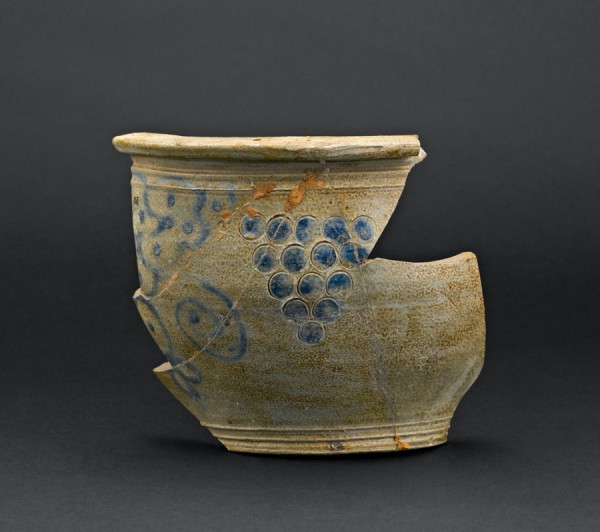
Chamber pot, Morgan pottery, Cheesequake, New Jersey, 1775–1784. Salt-glazed stoneware. (Courtesy, Robert J. Sim Collection, MCHA; photo, Gavin Ashworth.) This large fragment of a chamber pot contains an elaborate triangular design of impressed circles, partially colored in cobalt blue, adjacent to a wavy design with dots and a simple spiral.
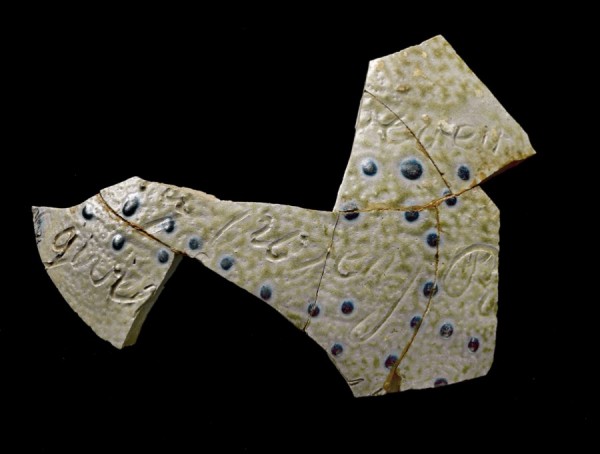
Sherd, Morgan pottery, Cheesequake, New Jersey, 1775–1784. Salt-glazed stoneware. (Courtesy, Robert J. Sim Collection, MCHA; photo, Gavin Ashworth.) On these assembled fragments is a pattern of cobalt-blue dots over illegible incised writing.
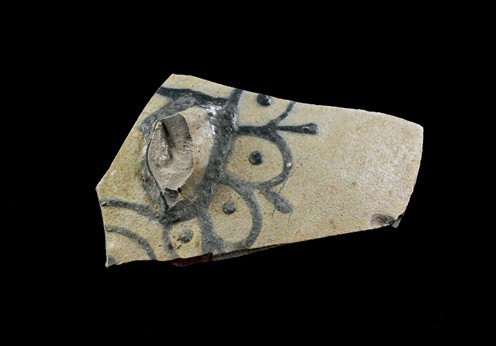
Sherd, Morgan pottery, Cheesequake, New Jersey, 1775–1784. Salt-glazed stoneware. (Museum Purchase/Gift of Mrs. Robert J. Sim, CH174.112, NJSM; photo, Gavin Ashworth.) Surrounding the base of a broken handle are adjoining circular ellipses with a dot in the center of each. The cobalt blue was applied with a slip cup. The decoration on this vessel fragment is similar to that illustrated in fig. 11: both surround the terminal of the handle and have a fragment of a watch spring.
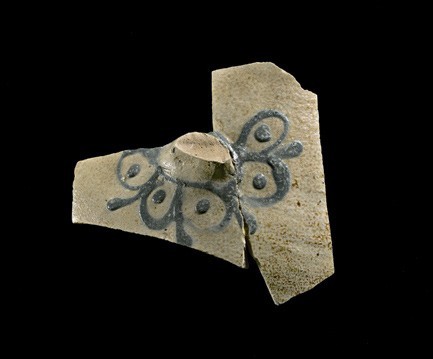
Sherd, Morgan pottery, Cheesequake, New Jersey, 1775–1784. Salt-glazed stoneware. (Museum Purchase/ Gift of Mrs. Robert J. Sim, CH174.112, NJSM; photo, Gavin Ashworth.) The decoration on this vessel fragment is similar to that illustrated in fig. 34, both surrounding the terminal of the handle.
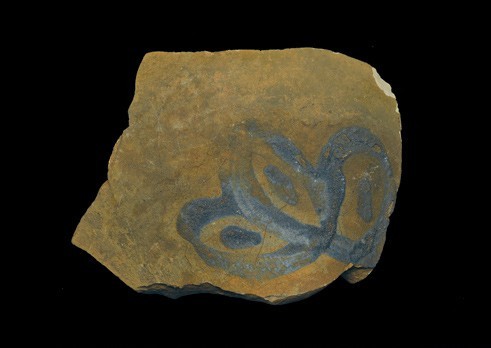
Sherd, Morgan pottery, Cheesequake, New Jersey, 1775–1784. Salt-glazed stoneware. (Courtesy, Arthur Clement Collection, Brooklyn Museum.) The central dots on these petals recall those found on the fragments illustrated in figs. 34, 35, and 41; the cobalt-blue decoration on this sherd, however, was applied with a brush.
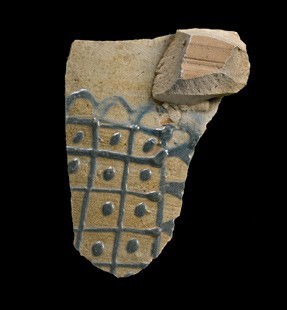
Sherd, Morgan pottery, Cheesequake, New Jersey, 1775–1784. Salt-glazed stoneware. (Courtesy, Robert J. Sim Collection, MCHA; photo, Gavin Ashworth.) The cobalt blue in this dotted matrix with wavy border was applied with a slip cup.

Sherds, Morgan pottery, Cheesequake, New Jersey, 1775–1784. Salt-glazed stoneware. (Courtesy, Robert J. Sim Collection, MCHA; photo, Gavin Ashworth.) This cobalt-blue decoration depicts rows of wavy lines; in two of the examples the lines alternate with rows of dots. The center example is the only Morgan sherd to have an interior slip— a medium brown color beneath the shiny salt glaze.
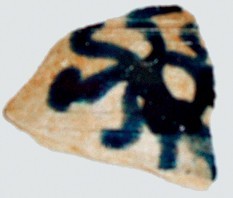
Sherd, Morgan pottery, Cheesequake, New Jersey, 1775–1784. Salt-glazed stoneware. (Courtesy: New Jersey State Museum, NJDOT and FHWA (NJ Division); photo, Leslie Warwick.)
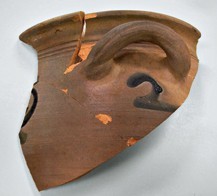
Sherd, Morgan pottery, Cheesequake, New Jersey, 1775–1784. Salt-glazed stoneware. Mark: inscribed “2” (Courtesy: New Jersey State Museum, NJDOT and FHWA (NJ Division); photo, Leslie Warwick.)
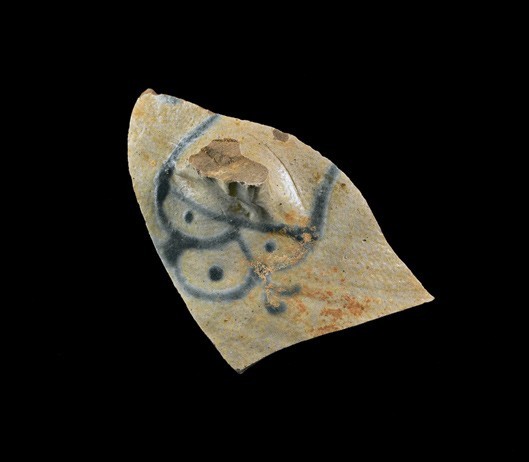
Sherd, Morgan pottery, Cheesequake, New Jersey, 1775–1784. Salt-glazed stoneware. (Museum Purchase/Gift of Mrs. Robert J. Sim, CH174.112, NJSM; photo, Gavin Ashworth.) The cobalt-blue dot centered within each of what might be fish scales is close to the three-tiered fish-scale design illustrated in fig. 42.

Detail of the 3-2-1 fish-scale design illustrated in James S. Brown Jr., “Notes on New Jersey Stoneware Potteries before 1850,” p. 21, undated draft, Robert J. Sim Collection, MCHA. (Courtesy, Robert J. Sim Collection, MCHA.) The source of Brown’s illustration is unknown.
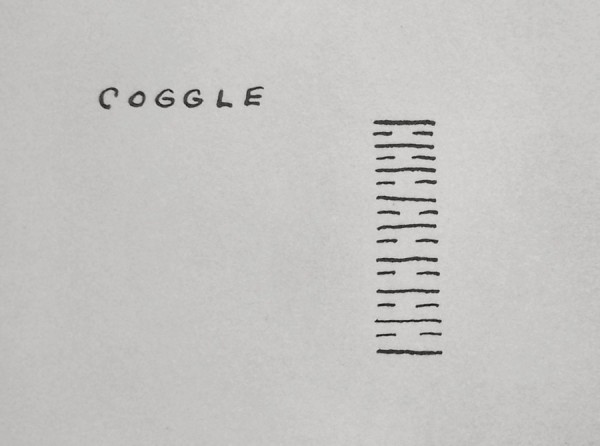
Sketch of the coggle pattern found on the first of two fragments recovered by Sim. The location of those sherds is not known.

Plate sherd, Morgan pottery, Cheesequake, New Jersey, 1775–1784. Salt-glazed stoneware. (Courtesy, Robert J. Sim Collection, MCHA; photo, Gavin Ashworth.) The two sides of this partially reassembled deep plate rim are decorated with spirals and swirls.
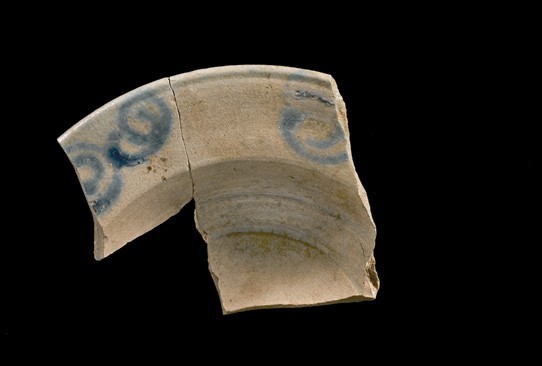
Deep plate sherd, Morgan pottery, Cheesequake, New Jersey, 1775–1784. Salt-glazed stoneware. (Courtesy, Robert J. Sim Collection, MCHA; photo, Gavin Ashworth.)
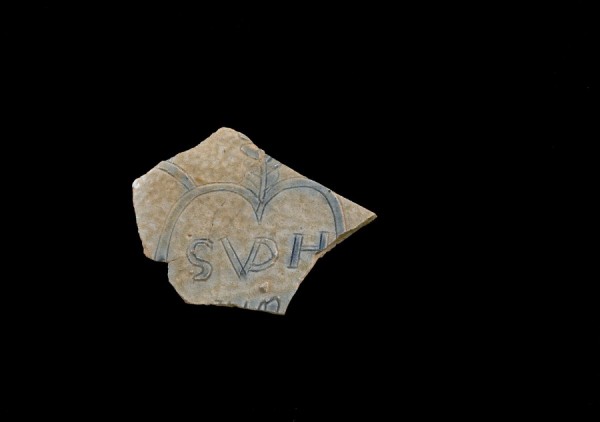
Flask or bottle fragment, Morgan pottery, Cheesequake, New Jersey, 1775–1784. Salt-glazed stoneware. Mark: incised “S VD[in ligature] H” within a heart. (Courtesy, Robert J. Sim Collection, MCHA; photo, Gavin Ashworth.)

Jar sherds, Morgan pottery, Cheesequake, New Jersey, 1775–1784. Salt-glazed stoneware. H. 13 1/2". (Museum Purchase/Gift of Mrs. Robert J. Sim, CH174.112, NJSM; photo, Gavin Ashworth.) These two fragments of this large jar bear a partial inscription: “. . . Danniel Holmes / . . . September 23, 1775 / . . . mboy James Morgan / & [M?] . . . .”
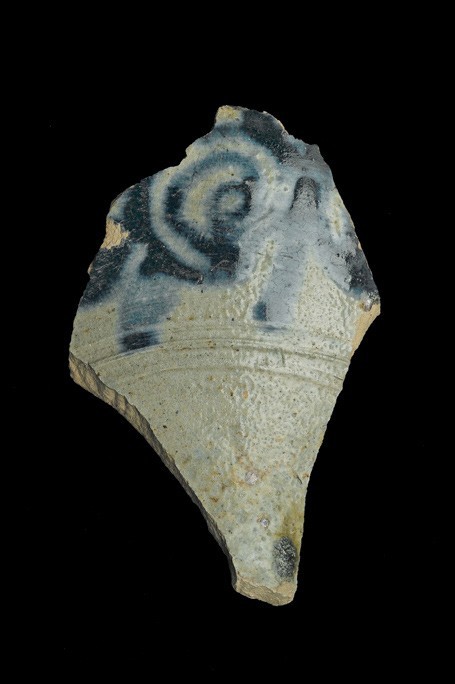
Sherd, Morgan pottery, Cheesequake, New Jersey, 1775–1784. Salt-glazed stoneware. (Courtesy, Arthur Clement Collection, Brooklyn Museum.)

Jug fragment, Morgan pottery, Cheesequake, New Jersey, 1775–1784. Salt-glazed stoneware. Mark: inscribed in cobalt blue, “Liberty / 1776” (Museum Purchase/Gift of Mrs. Robert J. Sim, CH174.112, NJSM; photo, Gavin Ashworth.) This large, partially reassembled jug bears a triangular dot pattern under the inscription and watch springs on both sides of the handle.
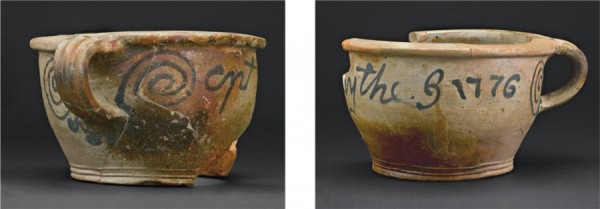
Chamber pot, Morgan pottery, Cheesequake, New Jersey, 1775–1784. Salt-glazed stoneware. Mark: inscribed “cpt [M]ay the 3 1776” (Courtesy, Robert J. Sim Collection, NJSM; photo, Gavin Ashworth.)
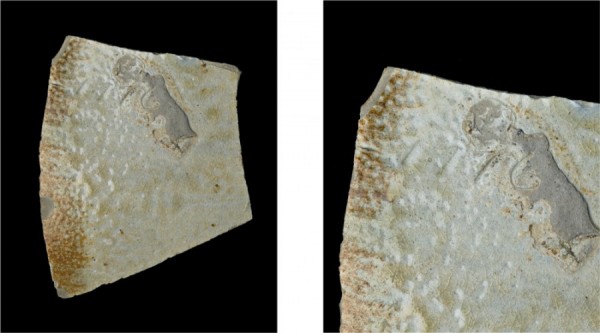
Sherd, Morgan pottery, Cheesequake, New Jersey, 1775–1784. Salt-glazed stoneware. Mark: impressed “1776” (see detail). (Courtesy, Arthur Clement Collection, Brooklyn Museum.)

Mug fragment, Morgan pottery, Cheesequake, New Jersey, 1775–1784. Salt-glazed stoneware. Mark: inscribed in cobalt blue, “1776” (Courtesy, Arthur Clement Collection, Brooklyn Museum; photo reproduced from Donald Blake Webster, Decorated Stoneware Pottery of North America [Rutland, Vt.: Charles E. Tuttle Co., 1971], p. 36, no. 16.)
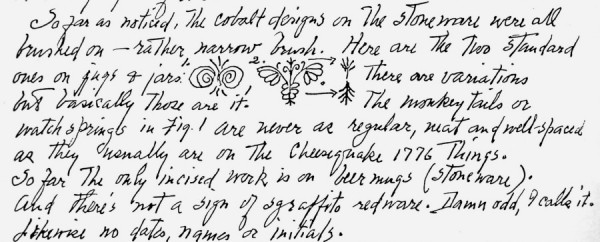
In a letter to James Brown Jr., Sim included sketches of the decoration on the Kemple sherds he found at Ringoes. (Courtesy, Robert J. Sim Collection, MCHA; photo, Leslie Warwick.)

Plate fragments, Kemple pottery site, Hunterdon County, New Jersey, ca. 1746–1790s. Salt-glazed stoneware. (Courtesy, Robert J. Sim Collection, MCHA; photo, Gavin Ashworth.)

Jar fragment, Kemple pottery site, Hunterdon County, New Jersey, ca. 1746–1790s. Salt-glazed stoneware. (Courtesy, Robert J. Sim Collection, MCHA; photo, Gavin Ashworth.) The incised cobalt-blue bands on this fragment are also seen on the fragment illustrated in fig. 56. Both show what appears to be part of a well-developed floral-like design with filamentous extensions.

Jar fragment, Kemple pottery site, Hunterdon County, New Jersey, ca. 1746–1790s. Salt-glazed stoneware. (Courtesy, Robert J. Sim Collection, NJSM; photo, Gavin Ashworth.) Similar to the sherd illustrated in fig. 55, this piece has incised cobalt-blue bands and a well-developed floral-like design.

Jar fragments, Kemple pottery site, Hunterdon County, New Jersey, ca. 1746–1790s. Salt-glazed stoneware. (Courtesy, Robert J. Sim Collection, NJSM; photo, Gavin Ashworth.)

Jar fragments, Kemple pottery site, Hunterdon County, New Jersey, ca. 1746–1790s. Salt-glazed stoneware. (Courtesy, Robert J. Sim Collection, NJSM; photo, Gavin Ashworth.) These four small fragments have partial images of pomegranates.
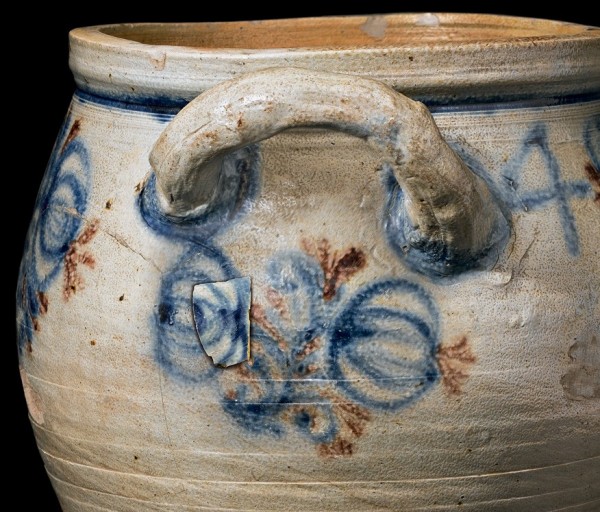
One of the pomegranate-decorated sherds recovered from the Kemple pottery site (illustrated in fig. 58) photographically superimposed on the attributed Kemple stoneware jar illustrated in fig. 6. (Photo composite, Gavin Ashworth.)
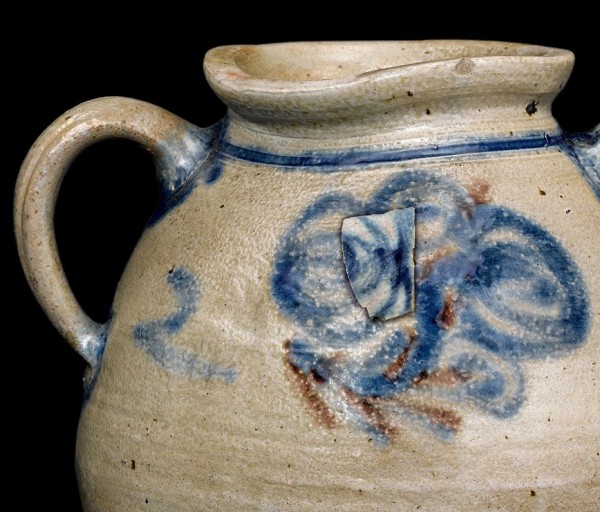
One of the pomegranate-decorated sherds recovered from the Kemple pottery site (illustrated in fig. 58) photographically superimposed on the attributed Kemple stoneware jar illustrated in fig. 7. (Photo composite, Gavin Ashworth.)

Sherds, Kemple pottery site, Hunterdon County, New Jersey, ca. 1746–1790s. Salt-glazed stoneware. (Museum Purchase/Gift of Mrs. Robert J. Sim, CH174.112, NJSM; photo, Gavin Ashworth.)

Mug fragment, Kemple pottery site, Hunterdon County, New Jersey, ca. 1746–1790s. Salt-glazed stoneware. (Courtesy, Robert J. Sim Collection, MCHA; photo, Gavin Ashworth.) One of two sherds (see also fig. 63) closely related to pottery made in the Westerwald region of Germany, this shows elaborate decoration, with an incised blue checkerboard pattern with three cobalt-blue bands and multiple tooled circular incised bands.
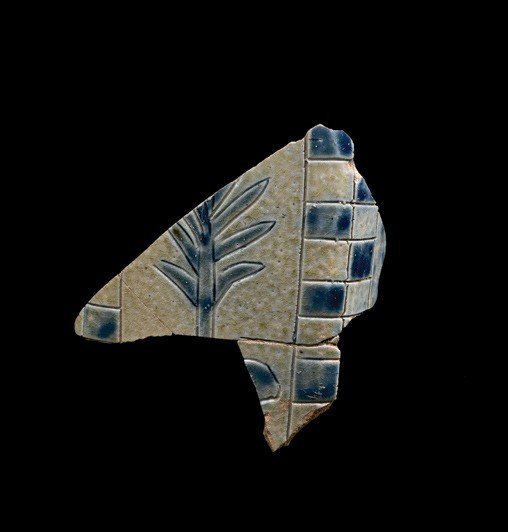
Square or rectangular bottle fragment, Kemple pottery site, Hunterdon County, New Jersey, ca. 1746–1790s. Salt-glazed stoneware. (Courtesy, Robert J. Sim Collection, MCHA; photo, Gavin Ashworth.) As does that illustrated in fig. 62, this fragment recalls pottery made in the Westerwald. The decoration here is an incised leafed branch on one side and a checkerboard pattern filled in with cobalt blue.
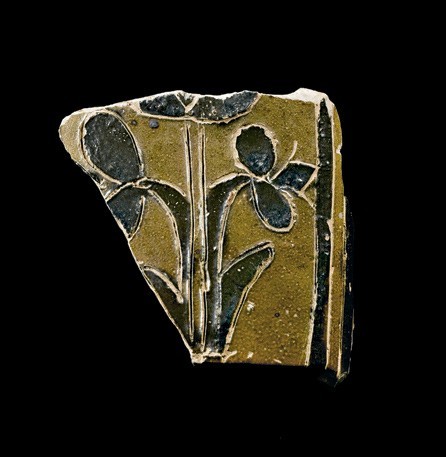
Probable teapot fragment, Kemple pottery site, Hunterdon County, New Jersey, ca. 1746–1790s. Salt-glazed stoneware. (Museum Purchase/Gift of Mrs. Robert J. Sim, CH174.112, NJSM; photo, Gavin Ashworth.) This fragment showing incised flower decoration is similar to a sherd Sim found at the Morgan pottery site (see fig. 24).
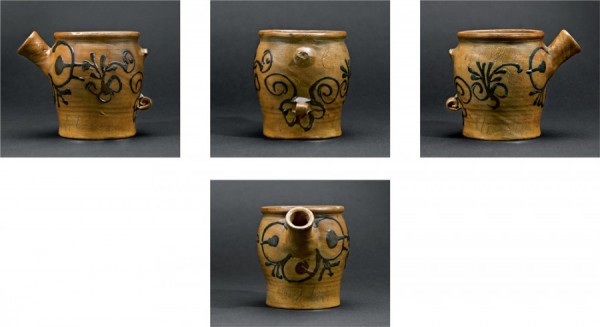
Spouted vessel, attributed to Adam States, Greenwich, Connecticut, ca. 1745. Salt-glazed stoneware. H. 4 1/2", W. 5 3/4". Mark: incised above base, “Elizabeth States her Pot”; below left rim, “E I S A S [illegible]” (Private collection; photo, Gavin Ashworth.) This vessel is missing its handle but retains its slightly flared spout.

Details of the inscriptions on the vessel illustrated in fig. 65.
